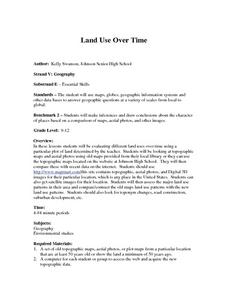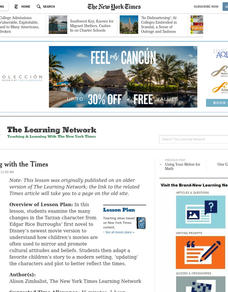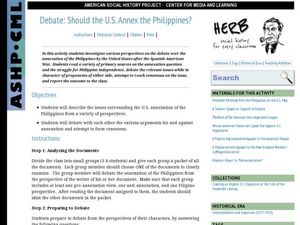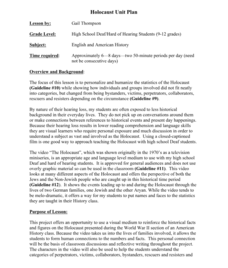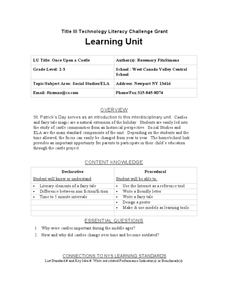New York City Department of Education
Geography and Early Peoples of the Western Hemisphere
Young historians discover the early people of the western hemisphere. The unit explores how the land changed, how it was used and homes of early Americans such as Incas, Mayans, Inuits, Aztecs, and Pueblos. Individuals also examine these...
Curated OER
Changes in Latitudes, Changes in Attitudes
Sixth graders discuss how people, society, and technology change over time through a unit of integrated lessons. In these changes in society lessons, 6th graders discuss the answers to many questions about how changes effect the...
Curated OER
Land Use Over Time
Students view aerial photos and topographic maps of their local area. They compare and contrast major land use patterns over time by comparing these images to maps that are at least 50 years old. They analyze them using the four land use...
US Institute of Peace
Becoming a Peacebuilder
"Be the change you wish to see in the world!" The 15th and final lesson in a peacebuilding series uses this quote from Gandhi to prepare pupils for their own action projects. Individuals research a global issue, then brainstorm a method...
Curated OER
Swinging with the Times
Young scholars examine the many changes in the Tarzan character from Edgar Rice Burroughs' first novel to Disney's newest movie version to explain how student movies are often used to mirror and promote cultural attitudes and beliefs.
Curated OER
"Rivers of Change"
Third graders research the Los Angeles River Basin and how it has changed over time.
Curated OER
People Change the Landscape
Students examine ways in which humans have brought change to the natural environment. In this ecology and literacy lesson, students listen to the book Island Boy by Barbara Cooney. Students observe and define map-reading vocabulary as...
Curated OER
Half Man, Half Limping Rabbit
Students explore culture and change through reading "Half Main, Half Limping Rabbit" by Nina Porzucki. In this literature and cultural lesson, students discuss Dracula and other folk stories from Romania. Students identify the ways the...
Curated OER
Continuity and Change
Students identify those freedoms most important to them and identify characteristics of a "good" rule. They then develop "good" rules for the world and identify how decisions or rules made today might affect the future.
Curated OER
Debate: Should the U.S. Annex the Philippines?
Building an argument with supporting evidence is a vital skill. Learners engage in a debate over the annexation of the Philippines after the Spanish-American War. They take on the perspective of an individual from that time period,...
Curated OER
Applying Ahimsa to Traditional Stories
Investigate the life of Mahatma Gandhi by researching non-violent lifestyles. Learners define the word ahimsa and discuss the personal characteristics that made Gandhi a peaceful warrior. They also create a poster about the story "The...
Western Illinois University
Holocaust Unit Plan
Would it have been you? Scholars investigate the horrors of the Holocaust during World War II. They view, interpret, and analyze the video The Holocaust to gain insight into who exactly was impacted by the events Europe. They then...
Curated OER
Once Upon a Castle
Students complete a variety of activities surrounding castle communities and fairy tales. They write a letter to a fairy tale character, write a fairy tale, create a model of a castle, and draw a map of a castle community.
Curated OER
Maquilapolis: Examining Incentives in a Market Economy
Students discuss the factors that influenced them to purchase a particular item. They work together to read and identify incentives of a character. They view a video on the topic as well.
Curated OER
Cinderella Stories: An African Tale
Students read and analyze an African version of the Cinderella story. They listen to John Steptoe's story, "Mufaro's Beautiful Daughters," locate Africa on a map, compare and contrast the story with Cinderella, and identify fairytale and...
Curated OER
Historical Fiction: A Wealth of Interpretations
Students read a book from the Dear America series and contrast different points of view. They respond to the book either by participating in a literature circle or completing a journal entry. They compare and contrast two books or a...
Curated OER
Mapping the Border
Students create maps of the borderland region. They decorate their maps with colors, pictures, icons, scenes, words that reflect their understanding of the character and history of the borderland.
Curated OER
Benjamin Franklin: Goods and Services in Colonial America
Fifth graders examine the impact of Benjamin Franklin's ideas on the goods and services available in Colonial America as well as analyze the importance of Franklin to modern society. While listening to "How Ben Franklin Stole the...
Curated OER
Exploring George Washington's Leadership
Students examine primary documents to determine whether or not George Washington was an honest leader. In this presidential history lesson, students evaluate Washington's leadership prior to and during his presidency. Guided reading...
Curated OER
Lewis and Clark for Grades PreK-2
Students read the "The Journey Begins" article and discuss why people want to discover new lands and why it is still exciting today. They are introduced to the idea that Lewis and Clark sent back discoveries to President Thomas...
Curated OER
Democratic Revolutions
Students study the Age of Revolutions. In this Latin America lesson, students consider how democratic revolutions around the world led to imperialism in Latin America.
Curated OER
Second Graders Create Their Own Social Studies Book
Students develop their own social studies textbook. Students gain knowledge of American immigration and Ellis Island. Students discover the process of becoming a naturalized citizen and what it means to be a citizen
Curated OER
Get to Know Your City
Third graders research the history of their home city and how it's development was influenced by different groups of people. They present their research information to the class.
Curated OER
Using Political Cartoons and Propaganda in Teaching the Holocaust
Young scholars gain an understanding of the Holocaust through analysis of political cartoons. In this Holocaust lesson, students examine propaganda in political cartoons that were used in Nazi Germany.


